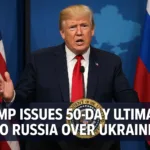
📅 July 2025 | 📍 Kathmandu – Nepal is grappling with the aftermath of catastrophic flash floods caused by a Glacial Lake Outburst Flood (GLOF), a climate-driven disaster that has claimed lives, destroyed key infrastructure, and underlined the urgency of adaptation in the Himalayan region. 🏔️🌍
⚠️ What Happened?
In early July 2025, a supraglacial lake — formed atop a glacier north of the Langtang Himal range — burst suddenly, releasing a deadly torrent of water into the Bhote Koshi River. 🌪️🌊
The flood obliterated the Friendship Bridge linking Nepal and China, washed away customs offices and homes, and left at least 9 dead and over 2 dozen missing. 😔🚨
📌 Impact Snapshot:
🔌 4 hydropower plants destroyed – nearly 8% of Nepal’s power capacity lost
🛤️ Major roads and bridges submerged or demolished
🚁 Emergency rescue operations ongoing
“This disaster is a stark warning. We are facing completely unprecedented glacial activity,” — ICIMOD Climatologist
❓ What Is a GLOF?
A Glacial Lake Outburst Flood happens when a glacial lake suddenly bursts through its natural dam, often made of ice or debris. This unleashes a wall of water that rushes down narrow valleys, wreaking havoc downstream. 🧊💥
🚨 Causes Include:
⛈️ Heavy monsoon rains
🌡️ Rapid snowmelt
🌍 Earthquakes
❄️ Weakening of glacial dams
🗻 Why Is Nepal at High Risk?
1. 🌡️ Accelerating Climate Change
Melting glaciers are enlarging glacial lakes, increasing the threat of sudden outbursts.
2. 🌧️ Monsoon Vulnerability
The monsoon season (June–Sept) brings heavy rains, triggering floods and landslides.
3. 🚫 Lack of Preparedness
Remote communities often lack early warning systems, risk maps, and disaster response training.
💔 Human and Economic Costs
👨👩👧👦 Lives Lost: Many missing; the death toll may rise.
🏚️ Displacement: Homes and livelihoods destroyed.
🔒 Trade Cut Off: Border trade with China disrupted.
🏗️ Infrastructure Wrecked: Bridges, roads, and power systems demolished.
🌐 International & Environmental Implications
🌏 Cross-Border Impact: Lake was in Tibet; devastation occurred in Nepal — revealing transboundary climate risks.
🌿 Ecosystem Damage: Sediment from floods is reshaping rivers and harming wildlife habitats.
🛡️ What Needs to Be Done?
1. 📡 Early Warning Systems
Install real-time lake monitoring and community alert systems.
2. 🧑🏫 Community Training
Evacuation drills and local disaster preparedness programs.
3. 🧱 Resilient Infrastructure
Invest in stronger, climate-resilient bridges, roads, and hydropower.
4. 🤝 Regional Cooperation
Nepal and its neighbors must share data, coordinate monitoring, and prepare together.
✅ Conclusion
Nepal’s July 2025 GLOF disaster is not an isolated tragedy — it’s a wake-up call to the global climate crisis unfolding in the Himalayas. ❗
With glacial lakes growing and monsoons intensifying, urgent investment in climate resilience, science, and international cooperation is more vital than ever. 🌍🆘
🗣️ “The next flood is not a matter of if, but when.” — Dr. Lhamu Sherpa, ICIMOD


